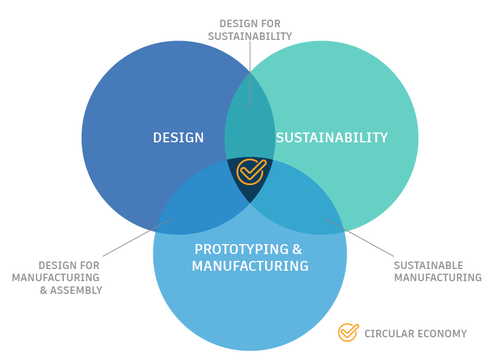Interest in Sustainable Design Surges
Product engineers are showing an increasing appetite for making sustainability a major design metric.
July 26, 2023

Companies that support the design process have noted a growing interest in sustainability design among their customers. Both Autodesk and Avnet have revealed surveys of customer interest that reveal surprising interest in adding sustainability to the design process. If sustainability is one of the primary goals as the product is conceived, designed, and prepared for manufacturing, there is an increased likelihood the product will meet higher environmental standards.
One of Autodesk's major goals is to help its customers with their sustainability efforts. “Eighty percent of the environmental impact of a product is determined at the design phase,” Zoe Bezpalko, senior sustainability strategy manager at Autodesk, told Design News. “We’re positioned to help customers reduce their environmental impact. This includes manufacturing, making, and operations.”
As for what it means for a product to be sustainable, Autodesk points to the concept of circularity. “I see circularity as the north star of sustainability,” said Bezpalko. “Circularity is the idea of keeping a product, its components, and/or materials at their highest value possible across the product lifecycle. In other words, nothing goes to waste.”
Autodesk recently noticed a surprising uptick in its customers’ interest in creating sustainable products. “Three years ago, we assessed sustainability at Autodesk, and 52% were interested in sustainability. Now 65% have sustainability goals,” said Bezpalko.

Sustainability Becomes a Major Design Factor
A recent study by electronics distributor, Avnet, has found that its customers view sustainable design solutions as important, especially visibility around availability and lead times (81%) and component end-of-life management (77%). Additionally, the survey uncovered what tactics are being implemented:
Most are currently using or planning to implement designing for longevity (77%) and low-power design (77%).
Nearly two-thirds are or plan to leverage connectivity (64%), software that prolongs product efficiency or life cycle (62%) or designing for recycling (60%) or reuse (57%).
Around half are or plan to avoid non-renewable resources (50%), edge computing (48%) or artificial intelligence (47%).
Like Autodesk, Avnet noted its customers are moving quickly to adopt sustainable design practices. “Our latest research indicates that efforts around sustainable design are further ahead than we may have anticipated, especially given the disruption to component availability and supply chains which have been a stringent focus these last couple of years,” said Stacy Mendez, director of global strategic planning at Avnet. “It is encouraging to see companies redirecting that focus to efforts that can help promote sustainable design in components and, beyond that, their end products.”
Avnet found customer demand is, by far, the most effective driver behind their customers’ use of sustainable design tactics. Forty, percent say customer pressure will be the most effective catalyst. Less than one-fifth believe government regulations (15%) or the desire to gain a competitive advantage (10%) will be an effective catalyst for advancing the use of sustainable design tactics.
“It is clear that customers are seeking sustainable options, which means demand for sustainably designed products will only continue to grow,” added Mendez. “Engineers should seek opportunities to incorporate sustainable design from the very start of the product development process. Therein lies the opportunity for customers to leverage the design and engineering capabilities of an end-to-end distributor to guide them from ideation to product development, even through to end-of-life, with sustainability priorities top of mind.”
About the Author(s)
You May Also Like





